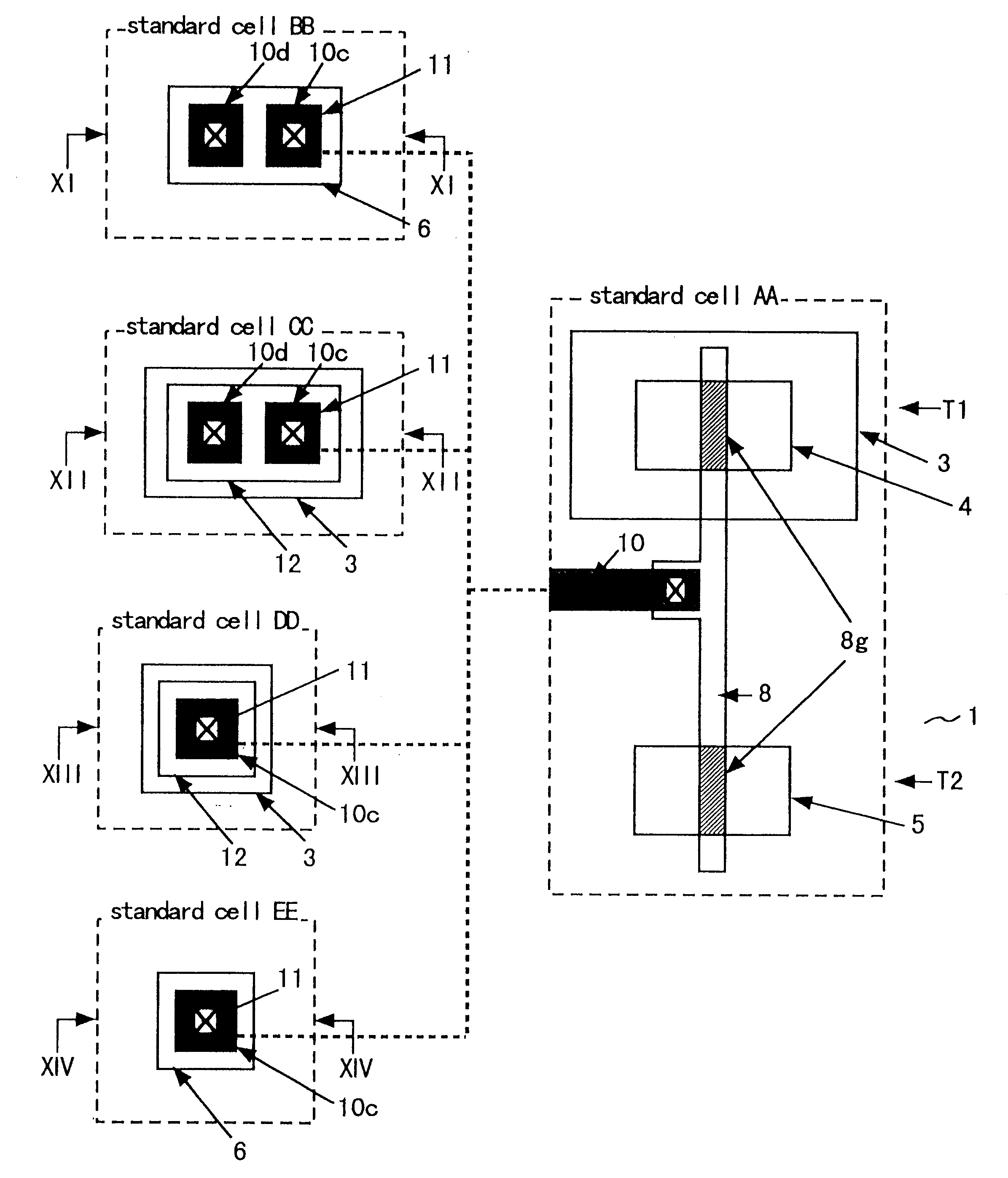Semiconductor device having a library of standard cells and method of designing the same
a technology of standard cells and semiconductor devices, which is applied in the direction of semiconductor devices, semiconductor/solid-state device details, electrical apparatus, etc., can solve the problems of deterioration of transistor characteristics, metal wiring lines, and mos transistor t1 or t2 gate oxide film being liable to be damaged by electrons
- Summary
- Abstract
- Description
- Claims
- Application Information
AI Technical Summary
Problems solved by technology
Method used
Image
Examples
first embodiment
FIGS. 1, 2, and 3 are diagrams for illustrating a configuration of a semiconductor device according to a first embodiment of the present invention. FIG. 1 is a plan view showing a layout pattern of a standard cell, FIG. 2 is a sectional view taken on II--II line in FIG. 1, and FIG. 3 is a sectional view taken on III--III line in FIG. 1.
Referring to FIGS. 1 to 3, there are shown a p-type silicon semiconductor substrate 1 (hereinafter referred to as p-substrate, or substrate, when appropriate), an isolation oxide film 2 formed on a surface of the p-substrate 1, an n-type well 3 (hereinafter referred to as n-well, when appropriate) formed in the p-substrate 1, a p-type diffused region 4 formed in the n-well 3, an n-type diffused region 5 formed in the p-substrate 1, and another n-type diffused region 6 formed in the p-substrate 1.
Shown also in FIGS. 1 to 3 are a gate oxide film 7 formed on the p-type diffused region 4 and the n-type diffused region 5, a polysilicon wiring line 8, gate ...
second embodiment
FIGS. 4 and 5 shows the configuration of a semiconductor device according to a second embodiment of the present invention. FIG. 4 is a plan view showing a layout pattern of a standard cell, and FIG. 5 is a sectional view taken on V--V line in FIG. 4. A sectional view taken on II--II line in FIG. 4 is similar to the sectional view shown in FIG. 2.
Referring to FIGS. 4 and 5, a metal wiring line 10 works as an input line for the MOS transistor in the standard cell. In FIGS. 4 and 5, components like or corresponding to those shown in FIGS. 1 to 3 are designated by the same reference numerals, and the description thereof will be omitted to avoid duplication.
In this second embodiment, the metal wiring line 10 serving as an input terminal is not cut. However, a diffused region 6 is formed under the metal wiring line (or metal terminal) 10, and the metal wiring line 10 is connected through a contact hole 11 to the diffused region 6.
Although the junction of the diffused region 6 and the wafe...
third embodiment
FIGS. 6 and 7 shows a configuration of a semiconductor device according to a third embodiment of the present invention. FIG. 6 is a plan view showing a layout pattern of a standard cell, and FIG. 7 is a sectional view taken on VII--VII line in FIG. 6. A sectional view taken on II--II line in FIG. 6 is similar to the sectional view shown in FIG. 2.
Referring to FIGS. 6 and 7, a relatively large n-type well 3 is formed in p-substrate 1, and a p-type diffused region 12 is formed on the surface of the n-type well 3. In FIGS. 6 and 7, and in the succeeding figures, well contacts are not shown for simplicity.
In the third embodiment, a metal wiring line, which serves as an input line (input terminal), is divided into metal wiring lines 10a and 10b. The metal wiring line 10a is connected to gates 8g, and the metal wiring line 10b serves as a metal terminal. The metal wiring line 10a and 10b are connected by a p-type diffused region 12 formed on the surface of the n-type well 3. The resistanc...
PUM
 Login to View More
Login to View More Abstract
Description
Claims
Application Information
 Login to View More
Login to View More - R&D
- Intellectual Property
- Life Sciences
- Materials
- Tech Scout
- Unparalleled Data Quality
- Higher Quality Content
- 60% Fewer Hallucinations
Browse by: Latest US Patents, China's latest patents, Technical Efficacy Thesaurus, Application Domain, Technology Topic, Popular Technical Reports.
© 2025 PatSnap. All rights reserved.Legal|Privacy policy|Modern Slavery Act Transparency Statement|Sitemap|About US| Contact US: help@patsnap.com



